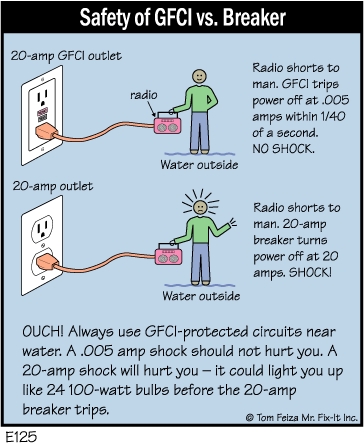 You may not know what a GFCI is, but chances are it’s making your home safer. A ground fault circuit interrupter (GFCI) measures current flowing through a circuit. It looks simple, but it’s really a complex electronic device.
You may not know what a GFCI is, but chances are it’s making your home safer. A ground fault circuit interrupter (GFCI) measures current flowing through a circuit. It looks simple, but it’s really a complex electronic device.
Electricity flows like water through a circuit. The GFCI measures this flow; if the device is operating properly, the flow into and out of the device should be the same. If the GFCI detects a slight leak of current (perhaps through your body), it immediately disconnects the circuit. That’s where the term “ground fault” comes from – the GFCI detects that the current is “grounding” when it’s not supposed to.
What about a circuit breaker or fuse? Wouldn’t one of these detect an imbalance? Circuit breakers and fuses are designed to prevent wires and devices from overheating. A 15-amp breaker will allow 15 amps of power to flow before it trips the circuit. That 15 amps is enough to light more than 15 100-watt bulbs; it’s enough current to kill a person. In fact, just a fraction of an amp flowing through your heart could be fatal. A GFCI will trip before that happens.
Remember to use the test button to check the GFCI periodically. Plug a lamp into the circuit; the lamp should turn off when you push the test button, tripping the GFCI.
